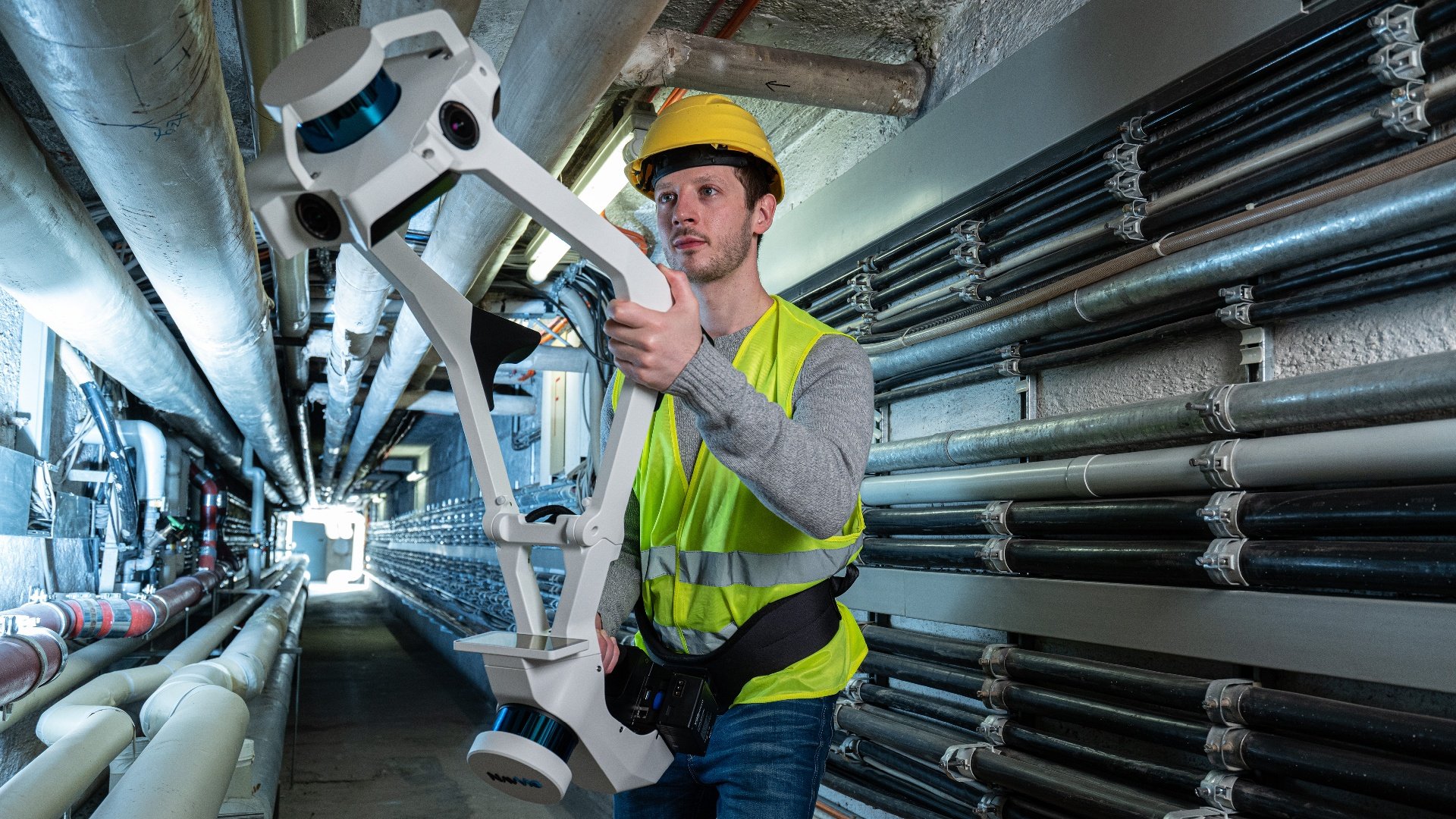We explain how the NavVis VLX wearable mapping system can significantly speed up your workflow – without sacrificing the accuracy your business relies on.
Terrestrial laser scanners (TLS) are great for capturing accurate, comprehensive 3D pictures of an environment. But they aren’t very fast.
An average 1500 sq m space can require up to 7 hours of work for a full capture—that’s a full day in the field. The same space would take as little as 30 minutes to capture with a dynamic indoor scanner.
In a recent webinar, NavVis demonstrated how their own dynamic indoor scanner NavVis VLX can speed up your workflow significantly, and do it without sacrificing the accuracy your business relies on.
Here are some highlights from the webinar. We’ll start by reviewing a few of the ways a dynamic scanner speeds up your workflow, and then take a look at a real-world project that demonstrates just how well these tools work in the field.
To skip the article and see the webinar for yourself, complete with some sample data sets, videos, and a detailed Q&A, click through here.
Use a mobile scanner to capture on the move
The biggest way that a dynamic scanner speeds up your workflow is by enabling you to capture as you move, explains Christian Dette, NavVis Technical Account Manager.
A TLS requires you to walk between positions, set up the scanner, wait for 5-15 minutes as it captures, and then repeat over and over again.
A dynamic scanner, he notes, captures as you walk. You simply walk through the environment (“at the speed of a gentle stroll on the beach with your partner”), and the device will automatically perform all the complex work of generating a detailed 3D model. If you want to capture panoramic imagery, simply stop for a second, hit a button, and continue on your way.
Use a mobile scanner to get faster coverage
The next way that a dynamic scanner speeds up your workflow is by getting coverage of complex areas much faster.
If you’re capturing a large machine with a TLS, Dette says, you might need at least four set ups to capture it from every angle. Since each scan could take up to 15 minutes with the industry’s most popular TLS, you’re looking at 60-75 minutes of scanning for that one object.
With a dynamic scanner like NavVis VLX, you can walk around the machine, capturing it from every angle as you go. Even if you stop to take pictures, you’ll be done in a minute or two.

Use a mobile scanner to remove reflections and moving objects automatically
Because a dynamic scanner captures while you move, it takes measurements of the same object from multiple angles. This is useful, Dette says, because it allows the scanner’s processing software to remove reflections and moving objects automatically. And this saves you time in the field.
Imagine you’re capturing an environment with reflective surfaces, like an office building with big banks of windows. If you use a TLS, you’ll need to plan extra scan positions to work around the reflective surfaces. This can take a lot of extra time.
If you use a dynamic scanner, Dette notes, it captures every part of the asset from multiple angles—giving it all the information it needs to eliminate reflections from your data automatically. You can walk by the reflections and be on your way.
The same goes for dynamic objects, like people or vehicles who move through your scan. Where they can disrupt a TLS scan, causing shadows in the data, the dynamic scanner can filter them out automatically and speed up your workflow significantly.
These are just a few of the ways that a dynamic scanner can speed up your workflow. (For more about the benefits of mobile scanning for documentation projects, see our article here.)
Proof: A real-world use case
To demonstrate what these benefits mean in the field, NavVis partner manager Marek Koltun explored four real-world projects during the webinar. Here’s a quick overview of one.
For this project, NavVis worked alongside LiRo Group, an engineering company located in Manhattan, to scan the anchorage of the RFK Bridge. It’s one of the busiest bridges in the United States, Koltun notes, with over 100,000 cars crossing in each direction every day. The goal was to obtain a rapid as-built data set to verify the existing model and add new parts the model as necessary.
The team estimated the size of the project at 10,000 sq m, a size that would take days of scanning with a TLS. Using NavVis VLX wearable scanner, he walked the bridge from side to side, climbing ladders and ducking into small spaces while on the move. He was able to finish in only 3 hours.
Koltun showed a video to demonstrate how he was able to scan from the bottom of the anchorage to the top—more than 100 meters in the sky—in only 25 minutes. “I cannot even imagine how many placements of a static scanner that would take,” says Marek, “or how much time you would spend in registration versus the self-registration of NavVis VLX.”
Learn more
This is just a quick overview of the information NavVis covered in its recent webinar, which includes a lot more information about how to do a full day’s scanning in 30 minutes.


